Click on images to enlarge
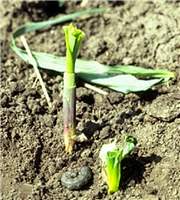
Cut stalk of a maize seedling with a cutworm next to the seedling. Image from University of Illinois at Urbana-Champaign http://ipm.illinois.edu/fieldcrops/insects/black_cutworm/index.html. All rights reserved.
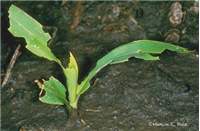
Leaves of maize seedling eaten by a cutworm. Image from University of Illinois at Urbana-Champaign http://ipm.illinois.edu/fieldcrops/insects/black_cutworm/index.html. All rights reserved.
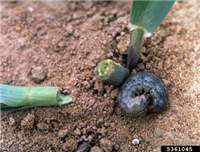
Cutworm (Agrotis ipsilon ) damage to maize seedling. ©W.M. Hantsbarger, Bugwood.org
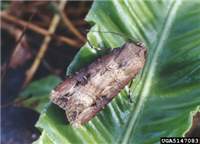
Adult Agrotis ipsilon . ©Ian Kimber, Bugwood.org http://www.ipmimages.org/browse/detail.cfm?imgnum=5147083
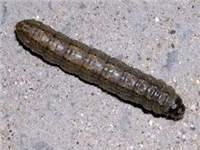
Larva of the black cutworm (Agrotis ipsilon). Image from "Animalandia"
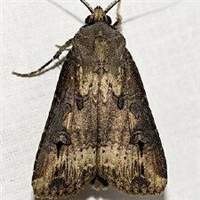
Adult of Black cutworm (Agrotis ipsilon) ©Karl Hilling, Mississippi Entomological Museum, Mississippi State University. All rights reserved.
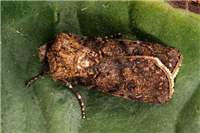
Agrotis segetum adult female moth at rest. ©David Agassiz (source CABI CPC)
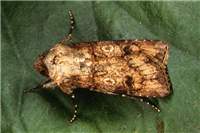
Agrotis segetum adult male moth at rest. ©David Agassiz (source CABI CPC)

Agrotis segetum adult female moth, set specimen. ©David Agassiz (source CABI CPC)

Agrotis segetum adult male moth, set specimen. ©David Agassiz (source CABI CPC)
Summary
This is a group of species belonging to the moth family Noctuidae. All cutworms are noctuids but not all noctuids are cutworms. The larvae (caterpillars) are indiscriminate feeders, causing damage to a variety of crops, mainly when the crops are young. Larger larvae may completely cut through stalks, which can cause plants to wilt and die.
Common Names
Species include the common cutworm, turnip moth (Agrotis segetum) and the greasy cutworm, black cutworm, tobacco cutworm (Agrotis ipsilon).
Synonyms
Taxonomic Position
Phylum: Arthropoda; Class: Hexapoda (Insecta); Order: Lepidoptera; Family: Noctuidae; Genus: Agrotis
Origin and Distribution
Different species of cutworm are found worldwide.
Description
Eggs
The eggs are pearly white, rounded, about 0.5mm in diameter. They are laid singly or in clusters of up to 2,000 eggs but generally between 600 and 800 eggs. Eggs are laid on vegetation, on moist ground around plants, or in cracks in the soil.
Larvae (caterpillars) plump, smooth caterpillars, greasy in appearance and can range in colour from grey to brown or black depending on the species. They may be up to 40mm long. Larvae generally have two spotted yellow stripes running down the back. The larvae curl into a C shape (grub-like or scarabaeiform ) when disturbed and remain motionless for a short period. They commonly hide just under the soil or litter by day or may be found on the soil surface adjacent to severed vegetation.
Adults
Adults are dark grey, black or brown coloured moths with markings on the front wings, which vary according to species. They have a wingspan of 40-50mm and are 20-30mm long. Females are darker than males but otherwise similar.
Similar Species
There are several species of cutworms that look very similar especially as larvae . These species include the black cutworm (Agrotis ipsilon), the brown cutworm (Agrotis longidentifera), the common cutworm (Agrotis segetum) and the grey cutworm (Agrotis subalba). The adult moths can be distinguished on the basis of wing shape and colour but this would require taxonomic expertise.
Life Cycle
Adult moths are nocturnal and lay eggs on vegetation, on moist ground around plants, or in cracks in the ground. Egg laying begins 5-11 days after emergence. The larvae hatch after 3 (at +29-30°C) to 24 days (at +10-12°C), and the young cutworms feed on vegetation near the ground. After 10-14 days they avoid daylight and become nocturnal feeders, remaining in the soil during the daylight hours. Larvae develop in 24-40 (sometimes 90-100) days, reaching 40-52 mm in length at the last 6th instar, depending on available food. When fully fed, the cutworms rest in the soil for about a week before pupating about 40 mm below soil level. The pupae stage lasts two to three weeks but may take up to two months depending on temperature. Depending on the species and latitude, one to three or four generations may occur in a year.
Pest Destructive Stage
Larva (caterpillar ) feeding on plants
Host Range
Cutworms are indiscriminate feeders, causing damage to a variety of crops, mainly when these are young. Among the crops that commonly suffer are maize, tobacco, potatoes, young coffee, cotton, asparagus, bean, beet, cabbage, castor bean, grape, lettuce, onions, cabbages, peanut, pepper, potato, radish, spinach, squash, strawberry, rice, rye and tomato.
Host Lifestage Affected
Seedlings and young plants.
Host Plant Part Affected
Stems, leaves in very young plants
Damage Symptoms
Cutworms usually feed at night or during overcast days. Newly hatched larvae feed on weeds, and/or young maize plants if present, leaving small irregular holes in the leaves. Such early feeding is of little significance to plants.
Larger larvae may completely cut through stalks, which can cause plants to wilt and die. Severe stand reductions can result. They sometimes drag cut plants under soil clods or into small holes in the soil to continue their feeding during the daylight hours.
In other crops like potatoes and root vegetables, damage can take the form of unsightly holes in the subterranean tubers, which may allow the penetration of secondary fungi.
When numerous, cutworms can destroy as much as 75% of a crop.
Pest Management
Detection
Cutworms can be difficult to detect because they are nocturnal. However, signs of cutworm damage such as holes in seedlings or plant parts just below the soil surface indicate their presence. Pheromone traps can be used to monitor cutworm adults.
Cultural practices
Cultural practices include the following: Plough and fallow fields before the planting season to prevent the laying of eggs, to expose the larvae or deeply bury the pupae; cultivate fields after vegetation has appeared and grown a few centimetres, and then delay seeding to starve the cutworms; cultivate frequently to injure and expose hiding cutworms to predators; dig in the soil around damaged or adjacent plants in the row and then find and destroy the disturbed cutworms; plant a thick "trap crop" of sunflower, a favoured host, around the perimeter of the garden and find and destroy attacking cutworms daily.
Biological control
The authors could find no examples of consistently effective biological control practices under field conditions.
Chemical control
Applications of the pyrethroids such as chlorpyrifos and organophosphates such as acephate can be used to control cutworms. They can be especially effective on first – third instar larvae when based on information from pheromone traps. Pesticides are poisons so it is essential to follow all safety precautions on labels.
Sources of Information and Links
CAB International (2007). Crop Protection Compendium. Wallingford, UK. CAB International.
Dall’Asta U. (2004). Moths and conservation values in East Africa: Noctuidae of the Taita Hills, Kenya. Journal of Insect Conservation 8: 191 - 198
Flanders K.L., Heinrichs E.A., Foster J.E. and Rice M.E. (2010). Maize pests of North America. In: EB Radcliffe, WD Hutchinson and RE Cancelado (Eds) Radcliff’s IPM world textbook.URL: http://ipmworld.umn.edu/chapters/maize.htm#White. University of Minnesota, St. Paul, MN.
Hill, D.S. (2008). Pests of crops in warmer climates and their control. Springer Science and Business Media BV.
Ortega, A. (1987). Insect pests of Maize: A Guide for Field Identification. Mexico, D.F.: CIMMYT.
Editors
Anne M. Akol, Makerere University; Maneno Y. Chidege, Tropical Pesticides Research Institute; Herbert A.L. Talwana, Makerere University; John R. Mauremootoo, BioNET-INTERNATIONAL Secretariat.
Acknowledgments
We recognise the support from the National Museums of Kenya, Tropical Pesticides Research Institute (TPRI) - Tanzania and Makerere University, Uganda. This activity was undertaken as part of the BioNET-EAFRINET UVIMA Project (Taxonomy for Development in East Africa).
Contact
BioNET-EAFRINET Regional Coordinator: [email protected]












